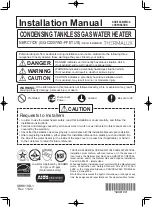
100271597
25
POLYPROPYLENE VENT SYSTEMS
Polypropylene vent systems do not use cement to connect
the pipe and elbow sections but use a push together gasket
seal method. Do not attempt to connect polypropylene
with sealant cement.
Polypropylene vent systems are designed to use specific
adaptors to connect into the rubber coupling on the top
of the blower. These are available through your venting
supplier.
The PVC vent termination elbow supplied with this heater
has been certified to be used with polypropylene vent
systems. A polypropylene to PVC end connection is
required and is available through your supplier.
Optional wall plates that fit the polypropylene venting are
also available through your supplier.
Carefully inspect the entire venting system for any signs of
cracks or fractures, particularly at joints between elbows
and other fittings and straight runs of vent pipe. Check
system for signs of sagging or other stresses in joints as a
result of misalignment of any components in the system. If
any of these conditions are found, they must be corrected
in accordance with the venting instructions in this manual
before completing installation and putting the water heater
into service.
The vent piping must be connected to the blower with
the rubber coupling and secured with gear clamps. The
coupling and clamps are provided with the heater.
Even though the flue gas leaving the blower is hot, some
installations will have water condense in the vent piping.
If this occurs, then adequate means of draining and
disposing of the condensate shall be made by the installer.
CONDENSATE
Condensate formation does not occur in all installations
of power vented water heaters, but should be drained
on installations where it can form in the venting system.
Condensation in the venting system of power vented
water heaters is dependent upon installation conditions
including, but not limited to, ambient temperature and
humidity of installation location, ambient temperature
and humidity of venting space, vent discharge and slope,
and product usage. In certain conditions, installations in
unconditioned space or having long horizontal or vertical
vent runs can accumulate condensate. Long lengths of
venting that pass through cool/cold areas will experience
condensation. The vent pipe should be sloped upwards
away from the blower assembly, then adequate means
for draining and disposing of the condensate needs to
be made by the installer. If installation conditions cause
condensation, install a condensate trap loop approximately
200mm (8 in.) in diameter using 3/8 in. plastic hose.
Connect the hose to the built-in drain port of the rubber
coupling of the blower assembly (see Figure 24). Loop the
hose in a vertical position as shown. The tube loop must
be filled with water at least half way prior to operating the
heater. Ensure the end of the tube has access to a drain
as condensate will flow from the end. Secure the tubing to
the side of the heater. Prior to operating the water heater,
make sure the removable cap is installed on the drain port
(if a drain hose is not needed).
Note:
This cap must remain in place if a drain hose is not
installed.
EXHAUST VENTING
This heater is designed to exhaust the products of
combustion (flue gases) to the outdoors using a sealed
piping system. Table 2 lists the allowable vent materials
and sizing information. Figure 27 shows the general
venting layout while Figure 28 thru Figure 30 show various
end termination details and clearances. Connection of the
venting piping to the blower is shown in Figure 31 thru
Figure 33.
Correct installation of the venting system is essential to
the safe and efficient operation of this water heater. Vent
piping must be installed in accordance with all applicable
codes. All installations shall meet the requirements as
stated in the current edition of the
“Natural Gas and
Propane Installation Code” B149.1
.
Note:
The information provided in Figure 25 is intended
as a guideline for good vent installation practices only
and is not intended to restrict venting options beyond
those restrictions established by the current edition of the
“Natural Gas and Propane Installation Code” B149.1
or any applicable local and state codes.
150mm
(6 in.)
min.
BACK TO BACK ELBOWS
NORMAL ELBOW
90° LONG SWEEP ELBOW
(LESS RESTRICTIVE)
90° SHORT SWEEP ELBOW
(MORE RESTRICTIVE)
STREET ELBOW
PREFERRED PRACTICE
Figure 25
Содержание GPVX 75L Series
Страница 50: ...50 100271597 NOTES...
Страница 51: ...100271597 51 NOTES...
Страница 52: ...599 Hill St West Fergus ON N1M 2X1 Phone 888 479 8324 Fax 519 787 5500 www hotwater com...
















































